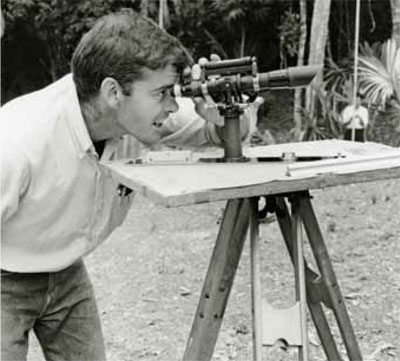
Dr. William R. Coe, Curator Emeritus of the American Section and Professor Emeritus in the Anthropology Department, was something of a legend within the Museum’s American Section. He learned his archaeology at Penn (B.A. 1950, M.A. 1953, and Ph.D. 1958), joined the Penn faculty as an Assistant Professor in 1959, and became an Assistant Curator at the Penn Museum that same year. Bill retired from Penn in 1987, and he died on November 23, 2009, at the age of 82.
Bill was widely known for his research and publications on Tikal, the great Classic Maya city in the rain forest of northern Guatemala. He joined the Museum’s Tikal Project in 1956. It was there that he honed his meticulous archaeological recording skills, producing superbly drawn archaeological sections, architectural drawings, and a cross-referenced catalog system, which have set the standards for Maya archaeologists to this day. Bill became the third and final director of the Tikal Project in 1963, a position he held until the project ended in 1970. A generation of American and Guatemalan Maya archaeologists were trained at Tikal under his leadership. His generosity in establishing an endowed American Section research fund some 30 years ago ensures that the Museum’s Maya research can be published to this day.
Most of Bill’s publications involved Tikal. His 1967 guidebook, Tikal: A Handbook of the Ancient Maya Ruins, is still in print. His 1965 Science article, “Tikal, Guatemala, and Emergent Maya Civilization,” initiated a search for the Pre-classic precursors of Classic Maya civilization that has revolutionized our understanding of the origins of lowland Maya states. But his monumental achievement remains Tikal Report 14: Excavations in the Great Plaza, North Terrace and North Acropolis of Tikal, published in 1990. This six-volume report exactingly documents 17 years of excavations in the heart of Tikal with over 1,000 pages of text and 238 excavation drawings.
The Penn Museum’s Tikal Project was instrumental in establishing this ancient Maya city as the national symbol of Guatemala. Today Tikal is one of the most visited archaeological sites in the Americas. In recognition of Bill’s commitment to the site’s archaeology, he received the highest honor bestowed by Guatemala, the Order of the Quetzal. And after his retirement in 1987, the Penn Museum confirmed his archaeological achievements by awarding him the Drexel Medal.
I was one of Bill’s students, and did my dissertation research in El Salvador under his supervision. I worked with him in 1971 when he directed a season of excavations at Tayasal, southwest of Tikal. In 1975, I spent a memorable field season with Bill at Quirigua, Guatemala, excavating that site’s royal acropolis. That was Bill’s final season of fieldwork—he spent the last 12 years of his career publishing his Tikal research. But I will always remember him for his support while I was a graduate student and during the early years of my academic career. And as an archaeologist, I will always honor him for setting rigorous standards for excavating and documenting archaeological sites.
